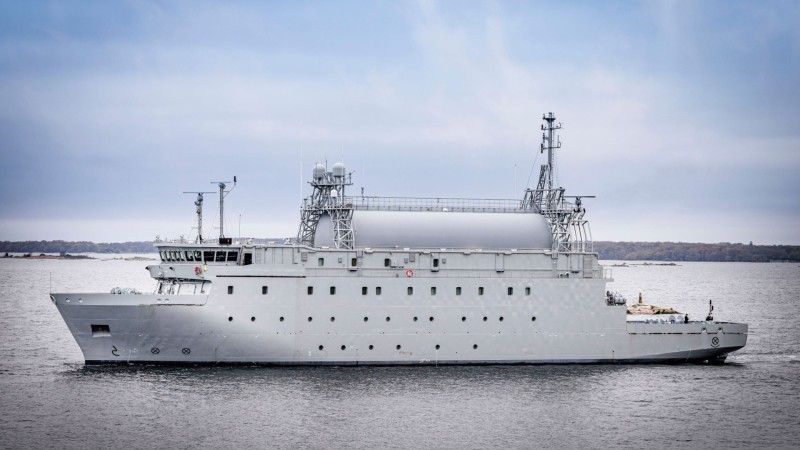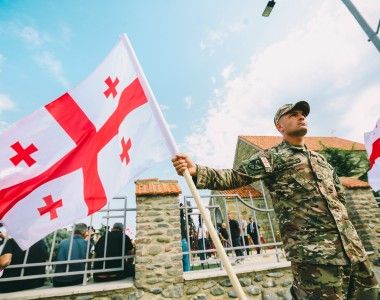Poland to Spend Billions on Polish-Swedish Delfin-class Vessels for its Navy

Photo. SAAB
The Swedish SAAB company signed an agreement with the Armament Agency representing the treasury, on the design, build, and support for two Delfin-class SIGINT/ELINT vessels. Remontowa Shipbuilding S.A. would be the Polish subcontractor for Saab. The design works would be outsourced to Gdynia-based MMC Ship Design & Marine Consulting Ltd.
Currently, the Polish Navy operates two Project 863 SIGINT vessels, assigned to the Reconnaissance Vessels Group of the 3rd Ships Flotilla: ORP Nawigator (262), and ORP Hydrograf (263). The reconnaissance equipment on both vessels was being regularly upgraded. This does not change the fact that they are quite old. ORP Nawigator was commissioned on 17th February 1975, while ORP Hydrograf entered service on 8th May 1976 - 47 and 46 years ago, correspondingly. Both vessels come from the Gdansk Northern Shipyard, currently known as Remontowa Shipbuilding.

Photo. Jarosław Ciślak/defence24.pl
The value of the contract is defined as ca. EUR 620 million (PLN 2.91 bn., considering the current currency exchange rate). The vessels are expected to be delivered by 2027. The agreement would become valid by the end of 2022, provided that the financial provisions defined by the Parties are met.
Sweden is currently engaged in sea trials of the brand-new Artemis (A202) SIGINT vessel. The design and building processes were taking place in Sweden, partially. The conceptual and mission equipment design processes took place in Sweden in their entirety. The technical and work design of the vessel itself, as a platform, and of its propulsion, have been authored by the Gdynia-based MMC Ship Design & Marine Consulting bureau. SAAB assigned the building process (excluding the SIGINT hardware) to the Nauta yard in Gdynia. Nauta outsourced the hull construction, and hull retrofitting (engine room) to PGZ SW in Gdynia. The keel for the Artemis vessel was laid on 15th June 2018.
Following the hull launching on 17th April 2019, the hull was towed by a tug to Nauta, to continue the process of fitting it with relevant equipment. Unfortunately, due to a variety of problems and challenges Nauta was facing at the time, the work was unfinished. The hull, without the relevant equipment, was then towed in February 2021 to Karlskrona, Sweden. There, the works were finalized. That made it possible to begin the sea trials. The vessel is expected to be commissioned soon.

Photo. SAAB
No specification details have been unveiled so far when it comes to the newly contracted Polish Delfin vessels. The design would probably be based on Artemis's, and it would be probably created by MMC Ship Design & Marine Consulting. Both vessels would be built and equipped at Remontowa Shipbuilding (except for the SIGINT equipment), and then be transferred to Sweden. There, they would receive all of the equipment, including SAAB's SIGINT suite.
These vessels are relevant and important for the Polish Navy. They would make it possible to retain SIGINT capabilities concerning the Kaliningrad area and track Russian movements in the Baltic, and other areas. Thanks to their relatively significant displacement and good seagoing capability and high levels of autonomy, the vessels in question will also be able to conduct longer missions, in the Bay of Finland for instance, or even to gather intelligence in the St. Petersburg or Kronstad areas, and get a closer look at the Northern Fleet.
When engaged in ELINT/SIGINT activities, defining the position of signal emission is as important as the interception of those signals. The interception of a single signal in 2 or 3 locations at once allows for accurate triangulation. The bigger the angle between the tracked signals, the greater the accuracy is. The Kaliningrad region is also being monitored by the land-based 6th Arendt Dickmann "Oliwski" SIGINT Center of the Polish Navy. However, retaining maritime capabilities within that scope (and placing it in the hands of the Reconnaissance Vessels Group of the 3rd Ships Flotilla) is also quite important. This is why we would be following the Delfin programme closely.

Photo. Jarosław Ciślak
The Swedish Artemis vessel has a displacement of 2,300 tonnes. It is 74 meters long, 14 meters wide, and has a draft of 3.8 meters. It is powered by azimuthal thrusters and features two bow manoeuvring thrusters, ensuring high levels of agility and the ability to maintain the desired position when at sea.
Ad.
ORP „NAWIGATOR" ORP HYDROGRAF RECONNAISSANCE VESSELS GROUP BASED IN GDYNIA-OKSYWIE OLIWA RADIOTECHNICAL CENTRE OF GDYNIA; DELFIN SAAB REMONTOWA SHIPBUILDING MMC



